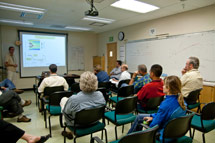
Handy Links
SLAC News Center
SLAC Today
- Subscribe
- Archives: Feb 2006-May 20, 2011
- Archives: May 23, 2011 and later
- Submit Feedback or Story Ideas
- About SLAC Today
SLAC News
Lab News
- Interactions
- Lightsources.org
- ILC NewsLine
- Int'l Science Grid This Week
- Fermilab Today
- Berkeley Lab News
- @brookhaven TODAY
- DOE Pulse
- CERN Courier
- DESY inForm
- US / LHC
SLAC Links
- Emergency
- Safety
- Policy Repository
- Site Entry Form

- Site Maps
- M & O Review
- Computing Status & Calendar
- SLAC Colloquium
- SLACspeak
- SLACspace
- SLAC Logo
- Café Menu
- Flea Market
- Web E-mail
- Marguerite Shuttle
- Discount Commuter Passes
-
Award Reporting Form
- SPIRES
- SciDoc
- Activity Groups
- Library
Stanford
Around the Bay
Getting Beam to the LCLS: A Day in the Main Control Center
Just after 4 p.m. on Wednesdays, people begin shuffling in to the conference room in SLAC's Main Control Center: operators, engineers, instrument scientists and users eager to start their experiments at the Linac Coherent Light Source.
The briefing starts at 4:15. Researchers give a short explanation of the science behind their proposed experiments, and outline the specific beam parameters they need to conduct them. Beginning on August 5, users on the Atomic, Molecular and Optical science instrument take the morning shift. At night, the beam moves to the Soft X-ray instrument.
It's up to the team of operators at the MCC to facilitate this transition between experiments twice a day and deliver a high-quality beam for each experimental shift. Of a dozen or so accelerator settings, the biggest difference between this week's experiments is the X-ray energy level; the AMO research needs a 2-kiloelectronvolt beam, while the SXR study calls for 930 eV.
"This is a pretty easy transition," said Mike Stanek, supervisor of the engineering operators-in-charge at the MCC. "Both groups are operating at about the same charge. When we have to switch between high and low charge, the transitions can take a few hours."
After the Wednesday meeting, the operators set out to prepare the beam for the first AMO shift, which starts Thursday morning. But before sending the beam to the hutches, they want to make sure everything is in working order. The group checks the source laser, which produces the electron bunches, as well as the energies and phases of the klystrons, which generate the high-power microwaves used to accelerate the bunches down the linac.
They also collect data from several points along the linac with the beam at full power—tests that provide a necessary baseline for tuning the X-ray parameters, Stanek explained. Then they adjust the pressure in the gas detectors, which help the users determine the power of each laser pulse, and finally send the beam through the undulators, where they can verify the power of the pulses.
The team saves the configuration of the optics in the accelerator, as well as the laser parameters from each shift, so they can upload settings and get started more easily than starting from scratch each time. But they still need to be on constant lookout for any flaws in the system. They each keep at least one eye trained on the colorful LCD screens that plaster the walls and desktops of the MCC, providing a constant flow of information about all the accelerator systems.
"Our people have to know a little bit about a lot of things," Stanek said. "They have to understand how the system works, then use their knowledge to react quickly as things come up." Accounting for a minor hardware problem in a klystron, for example, is just one of many day-to-day adjustments the team has had to make.
When the beam is on, the MCC runs a 24-hour operation, seven days a week. During each of the three, eight-hour work shifts every day, two or three accelerator systems operators and one engineering operator-in-charge—all part of SLAC's Accelerator Operations and Safety Division—man the controls. Accelerator physicists also provide performance support and a program deputy makes sure the accelerator schedule meets the users' needs.
While the Wednesday briefings are good for the MCC crew to get a sense of the week-long plan, users might request slight modifications as their experiments develop. "Sometimes they discover something they didn't anticipate, and they want to keep the same parameters longer, or try something different," Stanek said. "We have to be ready and able to make that happen."
The operators also have meetings each morning to discuss any problems from the night before. Last Friday, they learned that there were a few "blips" in the system. Shortly after 9 a.m., as they set up to shift the beam from the SXR to the AMO hutch, the computer that communicates with much of the source laser optics equipment crashed.
The room was suddenly abuzz with nervous activity, the clack-clacking of computer keys as they tried to reload the software, and one side of a phone conversation with a controls engineer, who helped to locate the problem. The operators were then able to fix the error, run through the beam diagnostics and set the parameters for the day. By 9:50, engineering operator-in-charge Robin Gold made the call to AMO to let them know they had a beam.
As the room became more relaxed, an operator off shift offered to go on a coffee run. Later, someone else might bring lunch, as the on-shift operators must remain in the control room, even for meals. More than one of them has oatmeal for breakfast, which they eat out of a Pyrex measuring cup.
"That's becoming a fad around here," said one engineer.
"Why don't we eat out of beakers?" another piped up.
"Save those for the coffee."
—Lauren Rugani
SLAC Today, August 12, 2010

